OSAC Newsletter, May 2017
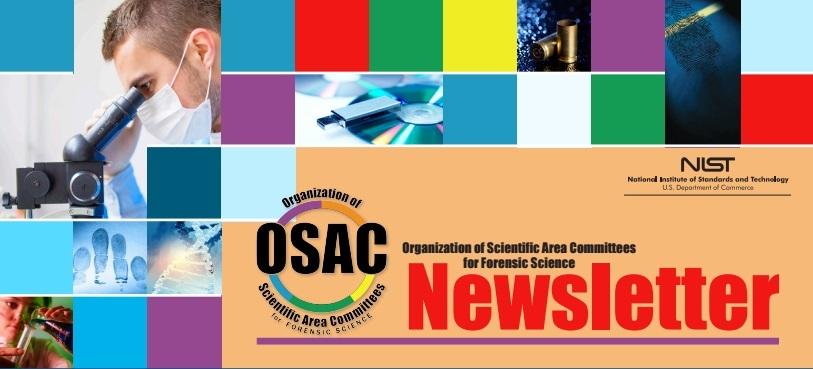
May 2017
Public Comment Period Open for Three Standards | Fire Debris and Explosives Analysis Subcommittee Position Statement on ASTM E1618-14 Standard Test Method for Ignitable Liquid Residues in Extracts from Fire Debris Samples by Gas Chromatography-Mass Spectrometry | Message from the FSSB: Successful Week at Full OSAC Meeting in Leesburg, VA | Message from OSAC Affairs Director: OSAC Operations Funded into FY 2018 | Standards Developing Organization (SDO) News | Status of Standards/Guidelines Recommended for Inclusion on OSAC Registry | On the Horizon | NIST Activities
Public Comment Period Open for Three Standards
The following documents are now open for public comment.
The intent of the public comment period is to collect public opinion on inclusion of the standard to the OSAC Registry (OSAC is not soliciting potential revisions to the documents themselves.) Comments should be specific as to why the document should or should not be on the OSAC Registry.
One standard was submitted by an OSAC Virtual Interdisciplinary Subcommittee (consisting of representatives from multiple OSAC subcommittees) for consideration:
This standard defines the content, format, and units of measurement for the electronic exchange of fingerprint, palm print, plantar, facial/mugshot, scar, mark & tattoo (SMT), iris deoxyribonucleic acid (DNA), and other biometric sample and forensic information that may be used in the identification or verification process of a subject. The information consists of a variety of mandatory and optional items. This information is primarily intended for interchange among criminal justice administrations or organizations that rely on automated identification systems or use other biometric and image data for identification purposes. One transaction may pertain to a specific subject, or contain information for multiple subjects. The definition for a given transaction should specify clearly whether all records apply to a single subject (such as in a criminal arrest transaction), have multiple records each of which applies to a different subject (such as a search result transaction), or have records that themselves contain multiple subjects (such as a Type-11 recording with multiple speakers). New editions of this standard are also available.
Two standards were submitted by the Materials (Trace) Subcommittee for consideration:
This test method covers a procedure for the quantitative elemental analysis of the following seventeen elements: lithium (Li), magnesium (Mg), aluminum (Al), potassium (K), calcium (Ca), iron (Fe), titanium (Ti), manganese (Mn), rubidium (Rb), strontium (Sr), zirconium (Zr), barium (Ba), lanthanum (La), cerium (Ce), neodymium (Nd), hafnium (Hf), and lead (Pb) through the use of Laser Ablation Inductively Coupled Plasma Mass Spectrometry (LA-ICP-MS) for the forensic comparison of glass fragments. The potential of these elements to provide the best discrimination among different sources of soda=lime glasses has been published elsewhere. Silicon (Si) is also monitored for use as a normalization standard. Additional elements may be added as needed, for example, tin (Sn) can be used to monitor the orientation of float glass fragments.
ASTM E3085-17 Standard Guide for Fourier Transform Infrared Spectroscopy in Forensic Tape Examinations
Infrared spectroscopy (IR) is a valuable method for the identification and comparison of pressure sensitive tapes. This guide provides basic recommendations and information about infrared spectrometers and accessories, with an emphasis on sampling techniques specific to pressure sensitive tape examinations. The particular method(s) employed by each examiner or laboratory will depend upon available equipment, examiner training, sample suitability, and sample size.
Instructions to provide public comments should be reviewed before submitting.
- Submit a Public Comment in Kavi on ANSI/NIST ITL-1 2011. Data Format for the Interchange of Fingerprint, Facial & Other Biometric Information.
- Submit a Public Comment in Kavi on ASTM E 2927-16 Determination of Trace Elements in Soda-Lime Glass Samples Using Laser Ablation Inductively Coupled Plasma Mass Spectrometry for Forensic Comparisons.
- Submit a Public Comment in Kavi on ASTM E3085-17 Standard Guide for Fourier Transform Infrared Spectroscopy in Forensic Tape Examinations.
Fire Debris and Explosives Analysis Subcommittee Position Statement on ASTM E1618-14 Standard Test Method for Ignitable Liquid Residues in Extracts from Fire Debris Samples by Gas Chromatography-Mass Spectrometry
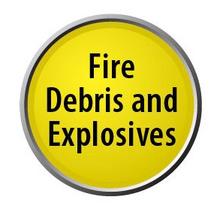
Although this document has served its purpose well, the expectations of the criminal justice community, and specifically of the OSAC process, require a significantly higher level of detail in standardized methods. E1618 represents the past 30 years of forensic practice but does not address the concerns that will dominate the future of forensic science.
This OSAC subcommittee has identified four areas in which to concentrate efforts for improvement. These four areas will be addressed individually, potentially as four separate documents. These areas are:
- Instrumental Analysis of ignitable liquids (IL) and ignitable liquid residues (ILR) by gas chromatography-mass spectrometry (GC-MS). Specific areas to be addressed include:
- Development of QA/QC measures for GC-MS instrumentation in the context of ignitable liquid analysis
- Refinement of criteria for instrument performance
- Development of appropriate QC test mixtures/test compounds based upon both analytes of interest and sample preparation/extraction techniques
- Ignitable Liquid Classification. Specific areas to be addressed include:
- Consideration as a standalone document to be used during interpretation
- Provision for better definition of and distinction between ignitable liquid classes
- Improvement in the classification of IL mixtures
- Refinement and revision of examples of products of each IL class
- Interpretation of GC-MS data for IL/ILR. Specific areas to be addressed include:
- Refinement of Extracted Ion Profiling (EIP) and requirements for single compound identification
- Enhanced identification criteria for all classes
- Inclusion of measures to address the interpretation of potential IL mixtures
- Report Writing. Specific areas to be addressed include:
- Enhancing verbiage to be clear and unbiased
- Defining and normalizing report terminology
If you have implemented improvements in any of these areas, please contact us with specific details at E1618.PathForward [at] gmail.com (E1618[dot]PathForward[at]gmail[dot]com).
Message from the FSSB: Successful Week at Full OSAC Meeting in Leesburg, VA
The FSSB would like to thank the 500+ OSAC Members and 85 invited guests who attended the Full meeting on April 18-21, 2017 in Leesburg, VA, working to continue collaboration on a forward approach to forensic science. We were fortunate to have an opportunity to celebrate our recent successes. First, since the last full meeting, we have generated five new standards and guidelines for the OSAC Registry.
Also, in recognition of outstanding and extraordinary efforts in the furtherance of the OSAC mission and objectives, the Distinguished Individual Service Award was presented to seven OSAC members by the Forensic Science Standards Board (FSSB).
The recipients of the Distinguished Individual Service Award were:
David Kaye, Legal Resource Committee (not pictured) – for critically reviewing standards, providing valuable advice to the SACs and subcommittees, as well as suggesting consensus-based modifications to documents to enhance their value for eventual inclusion on the OSAC Registry.
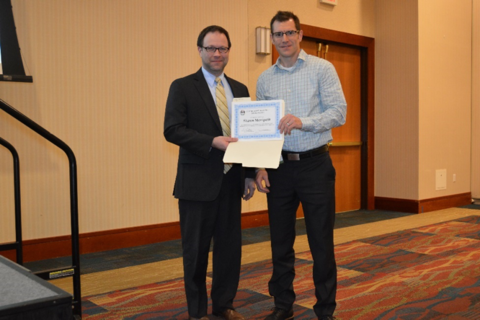
Shawn Montpetit, Biological Data Interpretation & Reporting Subcommittee – for maintaining regular conference calls and including input of many subcommittee members and affiliates, resulting in the development of two draft standards on DNA mixtures.
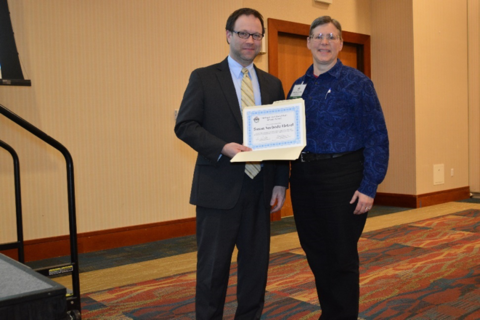
Sue Hetzel, Fire Debris and Explosives Analysis Subcommittee – for enabling productive interactions as the liaison between Fire Debris & Explosives Subcommittee and ASTM, and also between ASTM and other E30 disciplines.
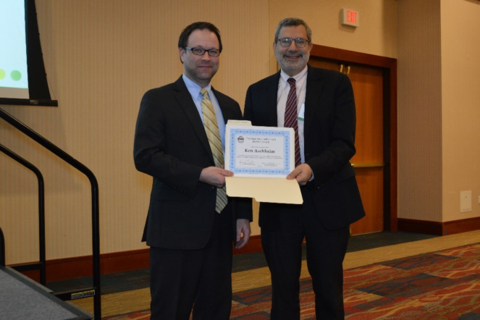
Ken Aschheim, Odontology Subcommittee – for guiding his subcommittee through the real world of the standards organization process in the approval of the American Dental Association’s (ADA) Technical Report No. 1088 Human Identification by Comparative Dental Analysis.
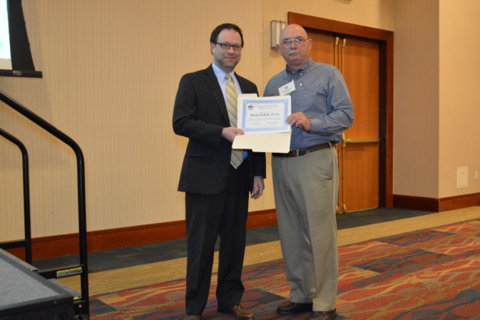
Mark Pollitt, Digital/Multimedia Scientific Area Committee – for answering the question, “Where is the ‘Science’ in Digital and Multimedia Forensic Sciences?”, by addressing the core issues raised by the National Academy of Sciences Report, the legal community, and scientists both inside and outside forensic practice.
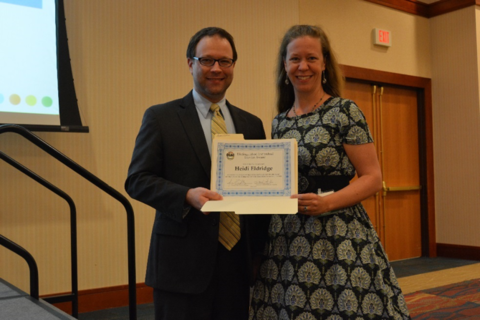
Heidi Eldridge, Friction Ridge Subcommittee – for establishing and maintaining communications between the Academy Standards Board (ASB) and OSAC, as well as coordinating the development of an overall framework for examinations and the specific criteria required at each step of the process.
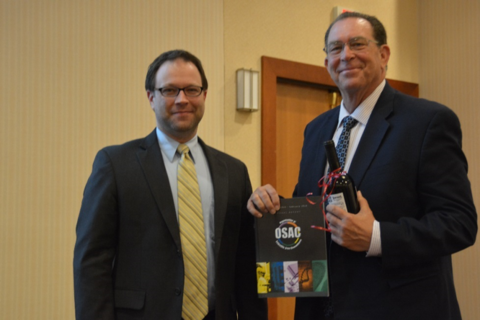
The Honorable Christopher J. Plourd, Legal Resource Committee Chair – for his outstanding work in the coordination of the legal community feedback related to standards under consideration for inclusion on the OSAC Registry.
Other notable meetings that occurred during the Leesburg, VA meeting were inter-disciplinary meetings (Virtual Subcommittee #3: ACE Process Map, and Virtual Subcommittee #4: Training, Continuing Education & Professional Development), and four pitch meetings (Seized Drugs Pitch Meeting, Speaker Recognition Subcommittee Pitch Meeting, and two Biological Methods Subcommittee Pitch Meetings).
The FSSB would like to thank OSAC Members for their dedication, hard work, and persistence in continuing to strive for excellence in reaching these goals.

On October 1, 2016, the Organization of Scientific Area Committees for Forensic Science (OSAC) began Fiscal Year (FY) 2017 operations using existing FY2016 funding. On May, 5, 2017, the President signed H.R. 244 into law which provided fiscal year 2017 full-year appropriations through September 30, 2017, for most federal agencies. Under this law, the National Institute of Standards and Technology (NIST) will receive a $3M transfer from the Department of Justice to fund OSAC operations. This funding will support OSAC’s operations into late FY 2018 which runs from October 1, 2017 – September 30, 2018, and allow us to continue hosting major meetings every nine months. Now that we have funding, OSAC Affairs is targeting the next set of OSAC meetings for January 16-19 & January 23-26 in 2018. We anticipate hosting half of the OSAC units during each week. Specific OSAC units have not been allocated to a given week at this time.
ASTM Committee E30 on Forensic Sciences Recent Activity
E30.01 Criminalistics
The following work items are underway:
ASTM WK58486 - Standard Practice for Examining Magnetic Card Readers Revision to E3017-15 (LINK EXPIRED)
ASTM WK58575 - Standard Guide for Establishing Confidence in Digital Forensic Results by Error Mitigation Analysis Revision to E3016-15e1
Newly Approved Standards:
E30.12 Digital and Multimedia Evidence
The following work item is underway:
ASTM WK58704 – New Practice for Facial Comparison Methods
E30 Withdrawn Standards
The following are ASTM Standards have been withdrawn:
ASTM E1658-08 Terminology for Expressing Conclusions of Forensic Document Examiners
ASTM E2285-08 Guide for Examination of Mechanical Checkwriter Impressions
ASTM E2286-08a Guide for Examination of Dry Seal Impressions
ASTM E2289-08 Guide for Examination of Rubber Stamp Impressions
ASTM E2494-08 Guide for Examination of Typewritten Items
Learn more about ASTM E30.
Status of Standards/Guidelines Recommended for Inclusion on OSAC Registry
The aim of the Organization of Scientific Area Committees for Forensic Science (OSAC) is to identify and promote technically sound, consensus-based, fit-for-purpose documentary standards that are based on sound scientific principles. This will be achieved through the OSAC Registry. A standard or guideline that is posted on the Registry demonstrates that the methods it contains have been assessed to be valid by forensic practitioners, academic researchers, measurement scientists, and statisticians through a consensus development process that allows participation and comment from all relevant stakeholders.
Below is a listing of standards or guidelines that are under consideration for the OSAC Registry, along with their status in the approval process.
Standards Documents Open for Public Comment
The intent of the public comment period is to collect public opinion on inclusion of the standard to the OSAC Registry (OSAC is not soliciting potential revisions to the documents themselves.) Comments should be specific as to why the document should or should not be on the OSAC Registry.
The following documents are now open for public comment.
One standard was submitted by an OSAC Virtual Interdisciplinary Subcommittee (consisting of representatives from multiple OSAC subcommittees) for consideration:
This standard defines the content, format, and units of measurement for the electronic exchange of fingerprint, palm print, plantar, facial/mugshot, scar, mark & tattoo (SMT), iris deoxyribonucleic acid (DNA), and other biometric sample and forensic information that may be used in the identification or verification process of a subject. The information consists of a variety of mandatory and optional items. This information is primarily intended for interchange among criminal justice administrations or organizations that rely on automated identification systems or use other biometric and image data for identification purposes. One transaction may pertain to a specific subject, or contain information for multiple subjects. The definition for a given transaction should specify clearly whether all records apply to a single subject (such as in a criminal arrest transaction), have multiple records each of which applies to a different subject (such as a search result transaction), or have records that themselves contain multiple subjects (such as a Type-11 recording with multiple speakers). New editions of this standard are also available.
Two standards were submitted by the Materials (Trace) Subcommittee for consideration:
This test method covers a procedure for the quantitative elemental analysis of the following seventeen elements: lithium (Li), magnesium (Mg), aluminum (Al), potassium (K), calcium (Ca), iron (Fe), titanium (Ti), manganese (Mn), rubidium (Rb), strontium (Sr), zirconium (Zr), barium (Ba), lanthanum (La), cerium (Ce), neodymium (Nd), hafnium (Hf), and lead (Pb) through the use of Laser Ablation Inductively Coupled Plasma Mass Spectrometry (LA-ICP-MS) for the forensic comparison of glass fragments. The potential of these elements to provide the best discrimination among different sources of soda=lime glasses has been published elsewhere. Silicon (Si) is also monitored for use as a normalization standard. Additional elements may be added as needed, for example, tin (Sn) can be used to monitor the orientation of float glass fragments.
ASTM E3085-17 Standard Guide for Fourier Transform Infrared Spectroscopy in Forensic Tape Examinations
This guide is intended for examiners with a basic knowledge of the theory and proficiency in the use of infrared spectroscopy as well as experience in the handling and forensic examination of pressure sensitive tapes. Further, this guide is to be used in conjunction with a broader analytical scheme.
Instructions to provide public comments should be reviewed before submitting.
Standards Documents in Public Comment Adjudication Phase
Public comment period is closed for the following standards/guidelines as OSAC units review and adjudicate comments received.
ASTM E2388-11 Standard Guide for Minimum Training Requirements for Forensic Document Examiners
This guide may not cover all aspects of training for the topics addressed or for unusual or uncommon examinations.
This practice describes procedures for preserving residues of ignitable liquids in extracts obtained from fire debris samples and questioned ignitable liquid samples.
Standards Documents at FSSB for Vote
One objective of a forensic glass examination is to compare glass samples to determine if they can be discriminated using their physical, optical or chemical properties (for example, color, refractive index (RI), density, elemental composition). If the samples are distinguishable in any of these observed and measured properties, it may be concluded that they did not originate from the same source of broken glass. If the samples are indistinguishable in all of these observed and measured properties, the possibility that they originated from the same source of glass cannot be eliminated. The use of an elemental analysis method such as inductively coupled plasma mass spectrometry yields high discrimination among sources of glass. This test method covers a procedure for quantitative determination of the concentrations of magnesium (Mg), aluminum (Al), iron (Fe), titanium (Ti), manganese (Mn), rubidium (Rb), strontium (Sr), zirconium (Zr), barium (Ba), lanthanum (La), cerium (Ce), neodymium (Nd), samarium (Sm), and lead (Pb) in glass samples.
Standards Documents in the Appeals Phase
The public appeals phase is open for the following standard. Appeals may only be submitted by individuals or groups that submitted a comment during the open public comment phase that believe their comment was not properly adjudicated. Submitted appeals must relate to the comment adjudication process, not technical issues.
This test method is for the determination of major, minor, and trace elements present in glass fragments. The elemental composition of a glass fragment can be measured through the use of μ-XRF analysis for comparisons of glass. This test method covers the application of μ-XRF using mono- and poly- capillary optics, and an energy dispersive X-ray detector (EDS).
• (Internal OSAC Meeting) June 1-2, 2017 FSSB meeting (Frankfort, KY)
• (OSAC Presentations) August 6-12, 2017 at the Annual IAI International Forensic Educational Conference (Atlanta, GA)
• (Internal OSAC Meeting) Fall OSAC Meetings, September 25-29, 2017, Florida: SAC + Resource Committees, September 25-26; OLSS 2.0 Meeting (FSSB + 24 Subcommittee Chairs), September 27; FSSB Meeting, September 28-29
NIST Activities
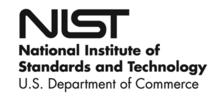
This section details other activities at NIST that may be of interest to OSAC stakeholders.
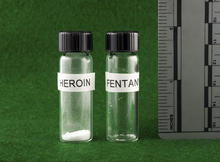 NIST Researchers Demonstrate Screening Techniques That Can Help Prevent Accidental Exposure to Synthetic Opioids
NIST Researchers Demonstrate Screening Techniques That Can Help Prevent Accidental Exposure to Synthetic Opioids

Dan Kallen, a detective in southern New Jersey, was searching a home with fellow officers in August 2015, when they found a bag of white powder. Kallen removed a scoop of powder for testing. When he was done, he closed the bag, and a bit of air escaped, carrying a puff of powder with it. It was enough to send Kallen and a fellow officer to the emergency room.
Read More


